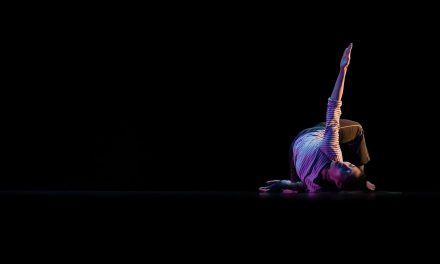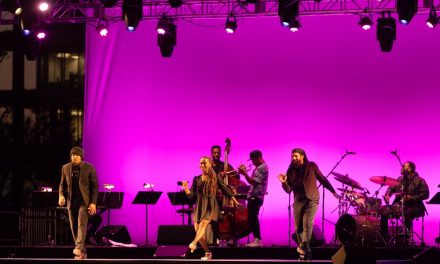Margie Gillis opened her “Legacy Project: Evolutions” with just a breath on Friday night—and her tiny gesture alone was enough to put the audience on the edge of their seats. The Théâtre Raymond Kabbaz, Los Angeles’ resident French theatre, though small, was full of dance enthusiasts hoping for the acclaimed solos of Gillis’ 45-year career. They were not disappointed. She began the evening with her solo “Blue,” to a cover of Leonard Cohen’s “Famous Blue Raincoat.” And with just a few movements from her chair, she made the space vulnerable and the air open. If the audience had forgotten, they were reminded: Gillis dances the feelings that we have all felt. That’s how she delivers the gut punch—by showing that she feels it herself.
The Legacy Project all-star cast, built of magnificent artists in their own right, featured Susan Paulson, Marc Daigle, Troy Ogilvie, Caitlin Griffin, Annmaria Mazzini, Neil Sochasky, Ruth Naomi Levin, and Adam Barruch. All stood among Gillis as she danced “Blue;” a few have learned it, but it’s one of the few that Gillis is reluctant to give away. They’ve all received the gift of her works through the last few years, as part of the Legacy Project. Thanks to an idea by Springboard Danse Montreal founder Alexandra Wells, Gillis began to give her love of creation and humanity to younger dancers—for the preservation of both the work itself and her intention, her spirit.
As she taught her repertoire to this next generation, Gillis began to assemble the rotating cast of the Legacy Project. Depending on which solos each dancer has, the show changes depending on the city, on the night. Pierre Lavoie handles the lighting and technical design, and the vignettes feature music from Erich Kory/J.S. Bach, Marianne Faithfull, Eugene Friesen, Suzie Leblanc/G.F. Haendel, Travis Laplante and Larsen Lupin: quite the spread.
Paulson and Daigle followed “Blue” with a patient duet whose name I don’t know (forgive me, for my Gillis vocabulary is more limited than I would like). Their soft, tender connection wasn’t necessarily anything new, but the familiarity was peaceful. Just as I began to tire of the pacing, they gathered themselves into a satisfying ending.
Ogilvie offered incredible articulation in Gillis’ “Bloom,” set to text from James Joyce’s “Ulysses.” Her unwavering attention to each detail brought meaning to every word in the narration. She was emotional and technical and abandoned all at once, a free precision to her execution. The words came in a steady stream, but Ogilvie was prepared for each one, batting at them with supple contractions and captivating expression.
Griffin brought the forest to life in “Loon,” conquering the straitjacket costume. This is Gillis’ movement invention at its height, quirky and humorous with the darkest edge. It’s surprising that Gillis gives a solo with such personal meaning to one of the Legacy Project dancers, but Griffin does it such sharp justice.
Neil Sochasky served as the focal point for antiwar mantra “Broken English,” set to Marianne Faithful’s tune of the same name. While this piece isn’t particularly exciting movement-wise, the then-revolutionary concept renews itself under today’s climate, and I found myself wanting to get up and thrash around with the cast.
Paulson returns to the stage for “Crow,” slinky and enticing. It’s easy to imagine Gillis in this role, staring the audience down and meeting their eyes one by one. Daigle crawls his way through a stream of light, straightening his blazer at the end and facing another day.
Then, Barruch takes the stage and turns an inhale into minutes and minutes of giant flowing circles in “Slipstream.” He is beguiling, reaching length of line I could never dream of. He is restless, giving into stillness not once. He draws a hypnotizing rhythm from which no eye can escape. And then the rest of the cast join him for a finale, Levin taking up the stage with joy and generosity.
Gillis pulls the best of the post-modern into contemporary and guides us into embracing our humanity. Though she may not be the newest of the new any longer, her solo works bear a certain comfort and age gracefully, adapting onto new bodies and reaching out to give the audience a hug.
Written by Celine Kiner for LA Dance Chronicle
Featured image: Margie Gillis – Legacy Project: “Evolutions” – Adam Barruch, Troy Ogilvie – Photo by Michael Slobodian











